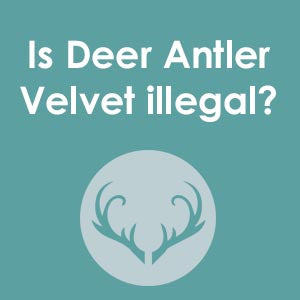Driving along a winding road in the country as the sun sets, you spot deer grazing in a field. The deer have beautiful, reddish-brown colored coats. Suddenly, the deer hear something and run away. As they run, you see the white underside of their tails. The deer you just saw are called "white-tailed deer," and they're named for the white part of their tail. They are a common site in many parts of the United States and Canada.
All deer are mammals with four hooves. They create the scientific family called "Cervidae." Along with the more common deer such as the white-tailed, there are many more unique types of deer throughout the world which you may never have seen, or even heard of. Let's take a look at five unique types of deer which can be found throughout our planet.
1. Pudu Deer
There are two kinds of pudu, which are the northern and the southern pudu. They're both found in South America. The northern pudu is the smallest deer in the entire world. It's only about 14 inches tall at its shoulder, which means it's just over one foot high. That's the size of a small dog! The southern pudu is slightly larger, typically about 18 inches tall at its shoulder, and its antlers are longer.
The antlers on the Pudus extend backwards from their heads, and the northern Pudu antlers are only about 2.4 inches in length.
The southern pudu antlers are about 3.5 inches long. The northern Pudu are found at very high altitudes in the Andes Mountains of Ecuador, Columbia, and Peru. The southern pudu also lives in the Andes Mountains, but they're found at lower altitudes than the northern ones, and they're located in Chile and Argentina.
2. Pygmy Brocket Deer
Another unique type of deer found in South America, the pygmy brocket deer is also a small, short-legged deer that weighs between 33 and 44 pounds. It's reddish-brown in color, and lives in Brazil, Paraguay, and Argentina. The pygmy brocket deer is a type of brocket deer, and there could be as many as 23 different kinds of brocket deer.
Some brocket deer are commonly found in places such as national parks, while other species are rarely ever seen. For instance, the pygmy brocket deer is a nocturnal and secretive kind of deer.
3. Chinese Water Deer
The water deer is found in Asia, in both Korea and China. This species of deer is also a small deer, which is about 22 inches tall at its shoulders. The most fascinating thing about this type of deer is that it actually has tusks instead of antlers. Their tusks are sharp, curved upper canine teeth that come out of their mouth, and these tusks can be more than two inches in length. It makes the water deer a very unique looking deer!
The male water deer are the ones who are typically about 20 to 22 inches tall at their shoulder, and weigh up to 29 pounds. Females tend to be smaller and weigh less than males. They weigh up to 24 pounds. The water deer's thick and coarse coat is a yellowish-brown color on top, and a yellowish-white color on its lower parts. Their ears are covered with fur to help keep them warm during cold winters.
Water deer like to eat the lush vegetation found along river bottoms. The grasses that they eat not only provide them with the food they need to survive, but also provide them with cover from predators. This type of deer likes to roam around on its own, and the male water deer will use their tusks to defend their territory.
4. Indian Muntjac
The muntjac deer are also called "barking deer," because they emit a loud, barking sound when they become alarmed. They are a small deer who are mostly found in southern Asia. The muntjac is one of the oldest known deer species, with existing fossils being 15 to 35 million years of age. There are about 12 different species of muntjac throughout southern Asia, and the indian muntjac is one of those species.
The indian muntjac has short and soft fur that is grayish or brownish in color. The muntjac's face is darker colored, and its limbs are a reddish-brown color. As the seasons change, their coat color can change too. The coloring can go from a brownish to a yellowish or grayish-brown color. Sometimes they also have markings that are creamy colored.
Adult indian muntjacs usually weigh around 39 pounds. This type of deer is an omnivore, which means they don't just eat grass. They also eat seeds, fruits, eggs, small animals, and even carrion. Male indian muntjacs have both short antlers and canine teeth, as well as a very large scent gland they use to mark their territory. Males are both more muscular and larger than females, and the females have bony knobs with fur patches on them instead of antlers. People can clearly see the longer canines on the males, while the females' canines are covered more by their upper lip.
5. Truong Son Muntjac
In April of 1997, the first recording of this unique species of deer was made by scientists. It was discovered during a forest survey in the Truong Son Range of Vietnam. This small kind of deer usually weighs about 33 pounds, and it lives on higher mountain ridges, at around 1,300 to 3,300 feet. This type of deer eats grasses, shoots, and leaves, and it's found in Vietnam and Laos.
The most fascinating things about this type of muntjac is that few people have ever actually seen a live one. There are no known western researchers who have seen a live one in person. The initial description of the truong son muntjac was based on discovered skulls. Between 2004 and 2014, there was no further evidence found concerning this species. Yet in 2014, a truong son muntjac was found in a trap by a forest guard, and it was released back into the wild. This incident was videotaped.
Thanks to modern technology, you can now see a truong son muntjac by simply watching the video.
There are many types of deer in this world, and some are much more beautiful than others. For example, the water deer with their long tusks would probably not be called "beautiful." Yet they all seem to have a sense of serenity and grace to them, unless they're frightened and running away. Deer, like the white-tailed, you can and probably have seen in many different places. Other, more unique deer, you will probably never see in person during your lifetime.
No matter what type of deer you may see or just read about online, they're always fascinating animals. While the types of deer highlighted in this article are interesting, they are not the type of deer used to extract our deer antler velvet ingredients. The deer we use at Pure Velvet Extracts are strictly North American Elk.

